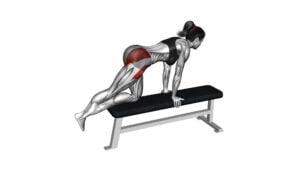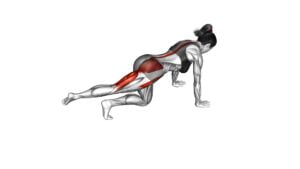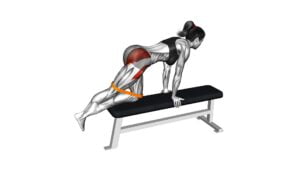Kneeling Leg Half Circle (male) – Video Exercise Guide & Tips

Get ready to challenge your leg muscles with the Kneeling Leg Half Circle exercise!
Watch This Exercise Video
In this video exercise guide, we'll show you the proper form and technique to maximize your results. Whether you're a beginner or advanced, we've got modifications and tips to increase the intensity.
Avoid common mistakes and get the most out of this exercise.
Let's get started and sculpt those legs!
Key Takeaways
- The Kneeling Leg Half Circle exercise improves flexibility and strengthens lower body muscles.
- Proper form and technique involve starting on all fours, extending one leg out to the side, and moving it in a half circle motion while engaging the core for stability.
- To increase intensity, resistance can be added with ankle weights or resistance bands, the leg can be fully extended, and the exercise can be performed slowly and with control.
- Beginners can modify the exercise by reducing the range of motion, using a support for balance, slowing down the pace, and focusing on proper form and control. Advanced individuals can increase the range of motion, add resistance, increase the speed of leg circles, perform more repetitions, and continuously challenge muscles and endurance.
Benefits of the Kneeling Leg Half Circle
Discover the numerous benefits of the Kneeling Leg Half Circle exercise for improving flexibility and strengthening the lower body. This exercise is highly effective in targeting specific muscle groups and promoting improved flexibility.
The Kneeling Leg Half Circle primarily targets the muscles in the lower body, including the glutes, hamstrings, and quadriceps. By engaging these muscle groups, this exercise helps to increase strength and stability in the lower body. Improved flexibility is another key benefit of the Kneeling Leg Half Circle. The circular motion of the leg helps to stretch and lengthen the muscles, promoting greater range of motion and flexibility.
Regularly incorporating the Kneeling Leg Half Circle into your workout routine can have a positive impact on your overall fitness and athletic performance. Increased flexibility can lead to improved posture, reduced risk of injury, and enhanced athletic performance. Additionally, strengthening the lower body muscles can improve balance, stability, and power during various activities and sports.
To perform the Kneeling Leg Half Circle, start by kneeling on all fours with your hands directly under your shoulders and your knees under your hips. Extend one leg out to the side, keeping it straight and in line with your hip. Begin to move your leg in a circular motion, first towards the front and then towards the back. Perform the desired number of repetitions and then switch to the other leg.
Proper Form and Technique for the Exercise
To ensure proper form and technique for the Kneeling Leg Half Circle exercise, focus on maintaining a stable position and engaging the targeted muscle groups. Here are some tips to help you perform the exercise correctly:
- Start by kneeling on a mat or soft surface with your hands placed shoulder-width apart in front of you.
- Extend one leg straight out to the side, keeping it parallel to the floor.
- Slowly move your leg in a half circle motion, bringing it towards the opposite side and then back to the starting position.
- Keep your core engaged throughout the movement to improve stability and prevent any unnecessary strain on your lower back.
Remember to start with a range of motion that's comfortable for you and gradually increase it as you become more familiar with the exercise. If you're a beginner, you can modify the exercise by bending your leg slightly or using a resistance band for added support. On the other hand, if you're more advanced, you can add ankle weights or increase the speed of your leg movement to make the exercise more challenging.
Tips to Increase Intensity and Challenge Your Muscles
To increase the intensity and challenge your muscles during the Kneeling Leg Half Circle exercise, here are some tips to help you incorporate progressive overload:
- Add resistance: Use ankle weights or resistance bands to increase the load on your muscles. Start with lighter weights or bands and gradually increase them as you get stronger.
- Increase range of motion: Fully extend your leg during the exercise to engage your muscles more effectively and increase the difficulty.
- Slow down the movement: By performing the exercise slowly and with control, you force your muscles to work harder and increase the intensity.
- Try an unstable surface: Perform the Kneeling Leg Half Circle on a balance board or foam pad to require more stability and activate more muscles to maintain balance.
Remember to listen to your body and progress gradually. Push yourself, but avoid overexertion or improper form. By incorporating these tips, you can increase the difficulty and challenge your muscles during the Kneeling Leg Half Circle exercise, leading to greater muscle activation and improved strength.
Modifications for Beginners and Advanced Individuals
To further customize the Kneeling Leg Half Circle exercise, modifications are available for beginners and advanced individuals. Whether you're just starting out or looking to push yourself to the next level, these modifications will help you tailor the exercise to your fitness level and goals.
Here are some beginner modifications to consider:
- Reduce the range of motion: If you're new to this exercise, start by performing smaller leg circles. This will help you build strength and stability in your core and hips before progressing to larger circles.
- Use a support: If maintaining balance is challenging, place your hand on a stable surface, such as a wall or chair, for support. This will help you focus on the movement without worrying about falling.
- Slow down the pace: Take your time with each leg circle and focus on proper form and control. Slowing down the movement will allow you to engage your muscles more effectively and reduce the risk of injury.
- Perform fewer repetitions: Start with a lower number of repetitions, such as five per leg, and gradually increase as you become more comfortable and confident with the exercise.
For advanced modifications, consider the following:
- Increase the range of motion: Challenge yourself by performing larger leg circles, extending your legs further away from your body. This will engage your muscles in a deeper range of motion and increase the difficulty of the exercise.
- Add resistance: Incorporate ankle weights or resistance bands to intensify the exercise. The added resistance will provide a greater challenge for your muscles and help you build strength and endurance.
- Increase the speed: Once you have mastered the exercise, try performing the leg circles at a faster pace. This will elevate your heart rate and add an element of cardiovascular fitness to the exercise.
- Perform more repetitions: As your strength and endurance improve, aim to increase the number of repetitions you perform per leg. Gradually work your way up to 10 or more repetitions to continue challenging your muscles.
Remember to always listen to your body and choose modifications that are appropriate for your fitness level. By customizing the Kneeling Leg Half Circle exercise, you can ensure that it remains effective and safe for your individual needs.
Common Mistakes to Avoid While Performing the Exercise
While discussing modifications for beginners and advanced individuals, it's important to be aware of common mistakes to avoid while performing the Kneeling Leg Half Circle exercise. Maintaining proper form is crucial to prevent injury and maximize the effectiveness of the exercise.
One common mistake is allowing the torso to lean forward or backward during the movement. To maintain proper form, keep the spine straight and engage the core muscles to stabilize the body.
Another mistake is lifting the leg too high or swinging it forcefully. This not only compromises the exercise's benefits but also puts unnecessary strain on the hip and lower back. Instead, focus on controlled movements and aim for a comfortable range of motion.
It is also important to avoid collapsing the supporting knee. Keep the knee directly under the hip and maintain a stable base throughout the exercise.
Lastly, remember to breathe properly. Holding your breath can lead to tension and reduce the effectiveness of the exercise. Inhale before starting the movement and exhale as you circle the leg.
Frequently Asked Questions
How Many Repetitions of the Kneeling Leg Half Circle Should I Do in a Workout?
To determine how many repetitions of the kneeling leg half circle you should do in a workout, it's important to focus on proper form and technique.
Start by kneeling on the ground with one leg extended to the side, then smoothly circle your leg in a half-circle motion.
Listen to your body and gradually increase the number of repetitions as your fitness level improves.
Can I Perform the Kneeling Leg Half Circle Exercise Without Any Equipment?
Yes, you can perform the kneeling leg half circle exercise without any equipment. This exercise is a great way to strengthen your core and improve your balance.
There are variations of this exercise that you can try to add more challenge or target different muscles.
By performing the kneeling leg half circle regularly, you can benefit from increased stability and flexibility in your lower body.
Remember to maintain proper form and start with a comfortable range of motion.
What Muscles Does the Kneeling Leg Half Circle Primarily Target?
The kneeling leg half circle primarily targets the muscles in your lower body, specifically your glutes, hamstrings, and quadriceps.
Incorporating this exercise into your lower body workout routine can provide several benefits, such as improving lower body strength, stability, and balance.
Additionally, there are modifications and variations available for different fitness levels, allowing you to tailor the exercise to your specific needs and goals.
Is the Kneeling Leg Half Circle Suitable for Individuals With Knee Problems?
If you have knee problems, the kneeling leg half circle may not be suitable for you. However, there are alternative knee-friendly exercises that you can try.
It's important to modify your workouts to accommodate your knee issues. Consult with a fitness professional or physical therapist who can provide guidance on exercises that are safe for your knees.
Can Performing the Kneeling Leg Half Circle Help Improve Flexibility in the Hips and Lower Body?
Performing the kneeling leg half circle can greatly improve flexibility in your hips and lower body. This exercise specifically targets the hip muscles, helping to increase their mobility and range of motion.
By regularly incorporating this movement into your workout routine, you'll experience the benefits of lower body flexibility, such as improved balance, enhanced athletic performance, and reduced risk of injury.
Adding this exercise to your fitness regimen can help you achieve your flexibility goals.
Conclusion
In conclusion, the kneeling leg half circle exercise offers numerous benefits for strengthening and toning the lower body.
By maintaining proper form and technique, you can effectively target your glutes, thighs, and core muscles.
To increase the intensity of the exercise, you can add resistance or modify the movement.
However, it's important to avoid common mistakes and ensure proper alignment to prevent injury.
Whether you're a beginner or advanced individual, this exercise can be adapted to suit your fitness level.

Author
Years ago, the spark of my life’s passion ignited in my mind the moment I stepped into the local gym for the first time. The inaugural bead of perspiration, the initial endeavor, the very first surge of endorphins, and a sense of pride that washed over me post-workout marked the beginning of my deep-seated interest in strength sports, fitness, and sports nutrition. This very curiosity blossomed rapidly into a profound fascination, propelling me to earn a Master’s degree in Physical Education from the Academy of Physical Education in Krakow, followed by a Sports Manager diploma from the Jagiellonian University. My journey of growth led me to gain more specialized qualifications, such as being a certified personal trainer with a focus on sports dietetics, a lifeguard, and an instructor for wellness and corrective gymnastics. Theoretical knowledge paired seamlessly with practical experience, reinforcing my belief that the transformation of individuals under my guidance was also a reflection of my personal growth. This belief holds true even today. Each day, I strive to push the boundaries and explore new realms. These realms gently elevate me to greater heights. The unique combination of passion for my field and the continuous quest for growth fuels my drive to break new ground.







